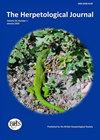Effects of environmental factors and conservation measures on a sand-dune population of the natterjack toad (Epidalea calamita) in north-west England: a 31-year study
IF 1.1
4区 生物学
Q3 ZOOLOGY
引用次数: 6
Abstract
A 31-year study monitored Britain’s largest natterjack toad population on the Sefton Coast sand-dune system in north-west England. Key objectives were to describe changes in numbers and breeding success, relate these to environmental variables and explore whether conservation efforts have been well targeted. Considerable variation was found in the number of water bodies used for spawning, the number of spawn strings laid and breeding success based on estimated toadlet production. There was a declining trend in annual totals of spawn strings and toadlets. Positive correlations were established between spring and April rainfall and both spawn count and toadlet production. April rainfall for the study area declined between 2000 and 2017. Premature desiccation of water bodies and associated poor breeding success were frequently observed, there being a positive relationship between water-table height and toadlet numbers. A long-term declining trend in the height of the water-table was established. The mean adult population of Sefton natterjacks was estimated at about 1200 individuals, with a peak around 3150. Successful breeding is increasingly reliant on management to excavate appropriately designed and managed “scrapes” that hold water long enough for metamorphosis to occur. Overgrowth of vegetation and loss of dynamism in the dune system threaten both the natural production of new breeding slacks and the natterjack’s open terrestrial habitat. Encouragement of dune dynamics by removing trees and scrub, increasing areas subject to livestock grazing and mechanical rejuvenation may offer the best hope of conserving this species in the future.环境因素和保护措施对英格兰西北部纳豆蟾蜍沙丘种群的影响:一项31年的研究
一项为期31年的研究监测了英格兰西北部塞夫顿海岸沙丘系统上英国最大的纳豆蟾蜍种群。主要目标是描述数量和繁殖成功率的变化,将其与环境变量联系起来,并探索保护工作是否有针对性。根据估计的蟾蜍产量,在用于产卵的水体数量、产卵串数量和繁殖成功率方面发现了相当大的差异。产卵串和蟾蜍的年总数呈下降趋势。春季和4月的降雨量与产卵数量和蟾蜍产量呈正相关。研究区域的4月降雨量在2000年至2017年间有所下降。经常观察到水体过早干燥和相关的繁殖成功率低,地下水位高度与蟾蜍数量呈正相关。地下水位高度长期呈下降趋势。塞夫顿纳豆的平均成年种群估计约为1200只,峰值约为3150只。成功的繁殖越来越依赖于管理,以挖掘设计和管理得当的“刮板”,这些刮板能保持足够长的时间,使变态发生。沙丘系统中植被的过度生长和活力的丧失威胁着新繁殖懒虫的自然生产和纳豆的开放陆地栖息地。通过移除树木和灌木、增加牲畜放牧面积和机械复兴来鼓励沙丘动态,这可能是未来保护该物种的最大希望。
本文章由计算机程序翻译,如有差异,请以英文原文为准。
求助全文
约1分钟内获得全文
求助全文
来源期刊

Herpetological Journal
生物-动物学
CiteScore
2.40
自引率
10.00%
发文量
25
审稿时长
>12 weeks
期刊介绍:
The Herpetological Journal is the Society''s prestigious quarterly scientific journal.
 求助内容:
求助内容: 应助结果提醒方式:
应助结果提醒方式:


